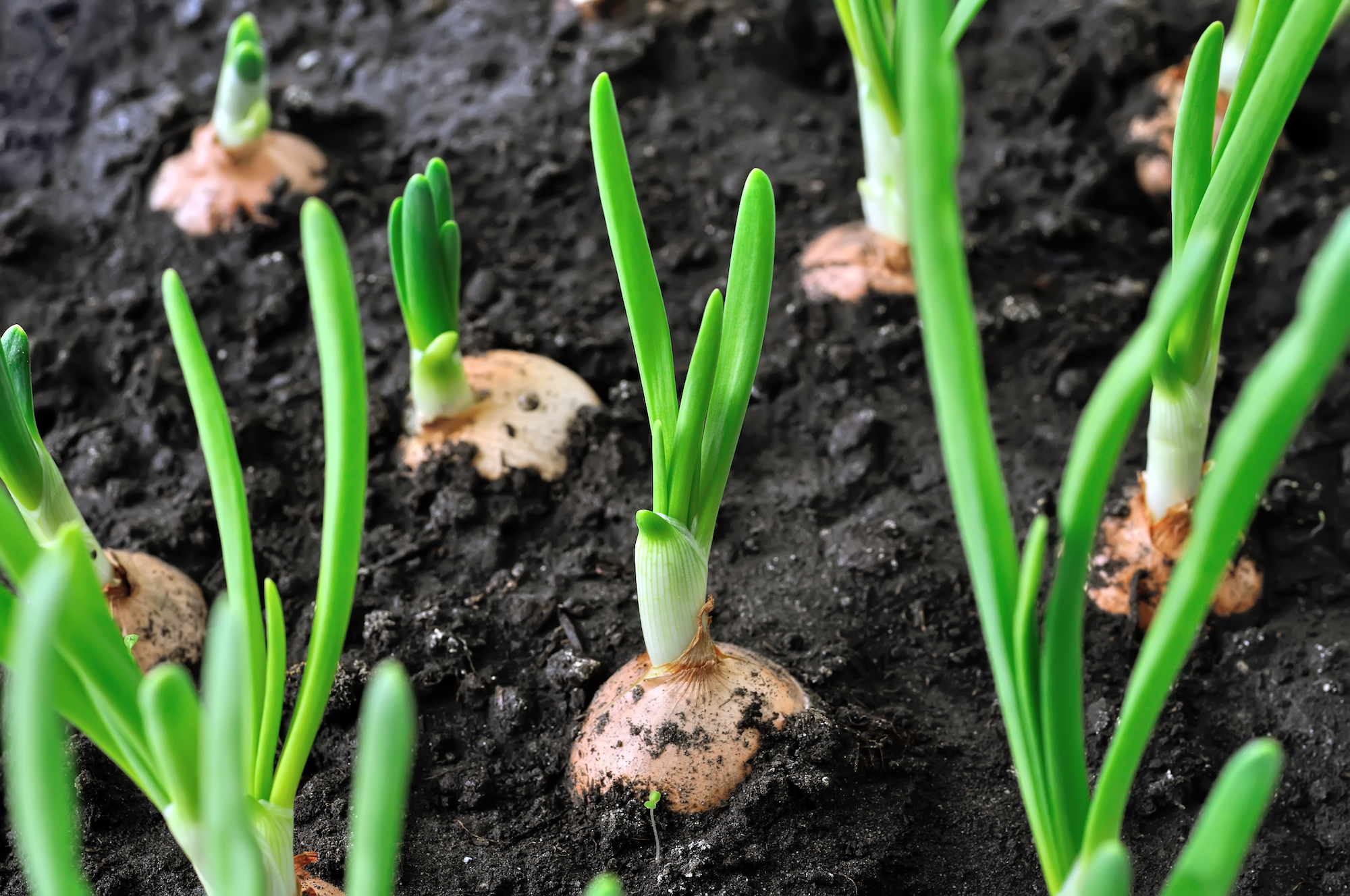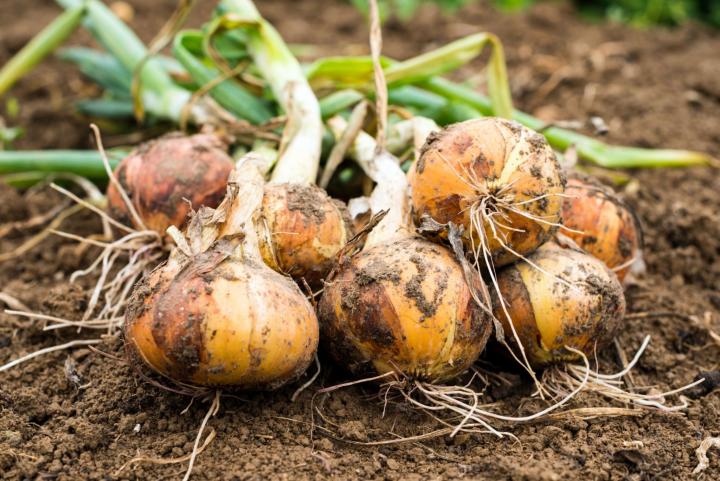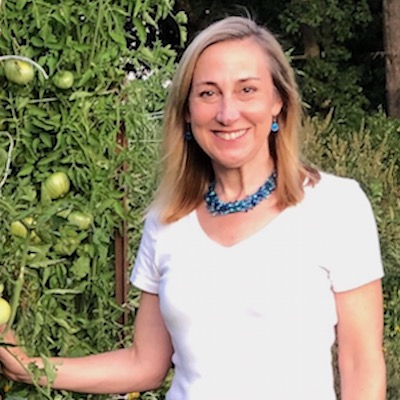
Learn how to grow onions from seed or sets with our complete guide
Read Next
Types
Onion varieties are categorized based on whether they’re “long-day,” “short-day,” or “day-neutral” varieties. This is because they are “photoperiodic,” meaning that they grow in response to day length—the number of daylight hours needed to trigger bulb formation.
Short-day onions grow best in the southern United States, between 25° and 35° north latitude. Start bulbs when day length reaches 10 to 12 hours. The earlier short-day onions are planted, the larger they get. In the South, onions can be planted in the fall and overwintered. Since they continue to grow throughout the winter, they will be ready for harvest in the spring.
Intermediate, or day-neutral, onions are best suited to the middle tier of U.S. states, approximately between the 32° and 42° latitudes. Start bulbs when day length reaches 12 to 14 hours.
Long-day onions grow best in the northern states, between latitudes 37° and 47°. Start bulbs when day length reaches 14 to 16 hours.
Do not try to fool Mother Nature: Short-day onions planted in a long-day zone will result in small bulbs—not an early harvest.
Long-day varieties:
- ‘Yellow Sweet Spanish’: large, round shape; yellow-white.
- ‘First Edition’: high-yielding, stores well, flavorful, creamy-yellow
- ‘Red Wethersfield’: flat bulbs that store well, white flesh, red-skinned
- ‘Aisa Craig’, ‘Walla Walla’: huge bulbs
- ‘Buffalo’, ‘Norstar’: produce early but keep only until late December
- ‘Copra’, ‘Southport Red Globe’, ‘Sweet Sandwich’, ‘Yellow Globe’: keep well
- ‘Red Florence’: heirloom; 4- to 6-inch-long, dark purple-red, torpedo shape; mild, sweet
- ‘Ailsa Craig’: heirloom; named for a Scottish island; large, up to 8 inches in diameter; average 2 pounds; pale yellow skin, globe shape; mild, sweet
- ‘Gold Coin’: cipollini; 1-1/2- to 3-inch yellow flattened bulb; pungent flavor sweetens when cooked
Short-day varieties:
- ‘Stuttgarter’: sold in sets, early maturity with a slightly flat shape, yellow
- ‘White Bermuda’: extremely mild, with thick, flat bulbs; white
- ‘Red Burgundy’: good table onion with mild, sweet white inside; short-term keeper
- ‘Crystal Wax White Bermuda’: a great onion for pickling when harvested at pearl size
- ‘Hybrid Yellow Granex’: sweet, Vidalia type
- ‘Red Creole’: heirloom; 3- to 4-inch, dark red globe shape; pungent
- ‘Southern Belle’: ruby color throughout
- ‘Texas 1015-Y Supersweet’: stores well
- ‘Yellow Granex’: Vidalia type; 3- to 4-inch, yellow, flattened globe shape; crisp; said to be the sweetest of the super sweet
Day-neutral or intermediate varieties:
- ‘Candy’: golden, thick-flesh, jumbo bulbs; stores well
- ‘Red Stockton’: large, red-ringed, white-flesh bulbs
- ‘Super Star’: large, sweet, white bulbs
- ‘Purplette’: mini onion, at 1-1/2 inches; glossy, burgundy red when raw; pastel pink when cooked or pickled; mild, sweet
- ‘Southport Yellow Globe’: early; 2-1/2- to 3-1/2-inch thick-skin yellow globe; mild, sweet
Gardening Products
Cooking Notes
To make onions taste milder, soak them in milk or pour boiling water over the slices and let them stand for 20 minutes. Rinse with cold water.
Chopping onions can sometimes look daunting: There’s the skin and the layers… Where to begin? Check out our tips for chopping onions in four easy steps. Onion skins actually have several health benefits, too, so don’t throw them out!
Check out more tips on using onions in the kitchen and cooking them correctly.
More Like This
Hi Cathy,
Sorry to hear about the issues with your onions. First off, you should pull and discard any of the onions that are showing signs of rot or mushy layers. Make sure to throw them away and never put them in your compost. There are a few reasons why some of your onions could be turning to mush. One could be too much water this late in the growing season. If you did not amend your soil prior to planting, your soil may be too compact and leading to drainage issues as the growing season went along.
There are also a number of diseases that can affect onions during the growing season. If you planted onions in the same location last year, disease may have been able to overwinter in that area and is now affecting this year's crop. It would be best to practice crop rotation next year and plant your onions in a different garden bed.
If your soil is in good growing condition and not oversaturated disease should be suspected. If your onions seem mature at this point (or close to it) it would be best to harvest them a little early to avoid any possible diseases from spreading to onions that are salvageable. Follow the instructions above for harvesting and drying before storage.
Hope this helps!
The bulb gets its food from the leaves, so one needs to wait until the leaves brown (and are no longer providing food) before harvesting the bulb, or the bulb won't reach its full size.
If a flowering stalk appears, however, you can cut off that green stem. Unfortunately though, if an onion bolts (forms flowers) the first year, it will no longer focus on bulb growth, even if one removes the flowering stem. It is best to immediately harvest an onion that has bolted, as the longer it sits in the soil, the more chance its flavor and texture may change and rot may occur. However, you can leave the bulb in the soil for a few days, if needed, before harvesting.
Hope this helps!
- « Previous
- 1
- 2
- …
- 10
- Next »













Comments